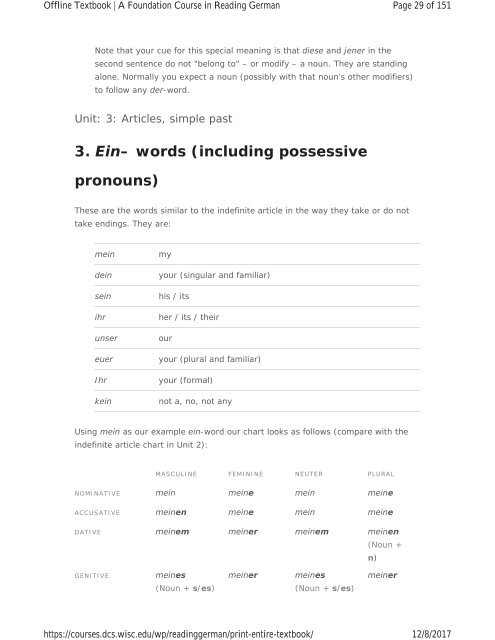A Foundation Course in Reading German, 2017a
A Foundation Course in Reading German, 2017a
A Foundation Course in Reading German, 2017a
Create successful ePaper yourself
Turn your PDF publications into a flip-book with our unique Google optimized e-Paper software.
Offl<strong>in</strong>e Textbook | A <strong>Foundation</strong> <strong>Course</strong> <strong>in</strong> Read<strong>in</strong>g <strong>German</strong><br />
https://courses.dcs.wisc.edu/wp/read<strong>in</strong>ggerman/pr<strong>in</strong>t-entire-textbook/<br />
Page 29 of 151<br />
12/8/2017<br />
Note that your cue for this special mean<strong>in</strong>g is that diese and jener <strong>in</strong> the<br />
second sentence do not "belong to" – or modify – a noun. They are stand<strong>in</strong>g<br />
alone. Normally you expect a noun (possibly with that noun’s other modifiers)<br />
to follow any der-word.<br />
Unit: 3: Articles, simple past<br />
3. E<strong>in</strong>– words (<strong>in</strong>clud<strong>in</strong>g possessive<br />
pronouns)<br />
These are the words similar to the <strong>in</strong>def<strong>in</strong>ite article <strong>in</strong> the way they take or do not<br />
take end<strong>in</strong>gs. They are:<br />
me<strong>in</strong><br />
de<strong>in</strong><br />
se<strong>in</strong><br />
ihr<br />
unser<br />
euer<br />
Ihr<br />
ke<strong>in</strong><br />
my<br />
your (s<strong>in</strong>gular and familiar)<br />
his / its<br />
her / its / their<br />
our<br />
your (plural and familiar)<br />
your (formal)<br />
not a, no, not any<br />
Us<strong>in</strong>g me<strong>in</strong> as our example e<strong>in</strong>-word our chart looks as follows (compare with the<br />
<strong>in</strong>def<strong>in</strong>ite article chart <strong>in</strong> Unit 2):<br />
MASCULINE FEMININE NEUTER PLURAL<br />
NOMINATIVE me<strong>in</strong> me<strong>in</strong>e me<strong>in</strong> me<strong>in</strong>e<br />
ACCUSATIVE me<strong>in</strong>en me<strong>in</strong>e me<strong>in</strong> me<strong>in</strong>e<br />
DATIVE me<strong>in</strong>em me<strong>in</strong>er me<strong>in</strong>em me<strong>in</strong>en<br />
(Noun +<br />
n)<br />
GENITIVE<br />
me<strong>in</strong>es<br />
me<strong>in</strong>er<br />
me<strong>in</strong>es<br />
me<strong>in</strong>er<br />
(Noun + s/es)<br />
(Noun + s/es)


















